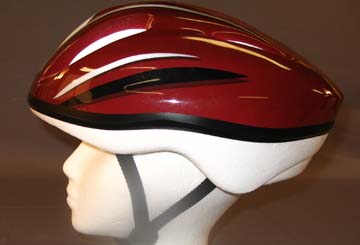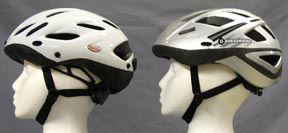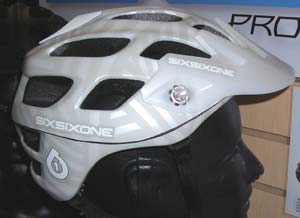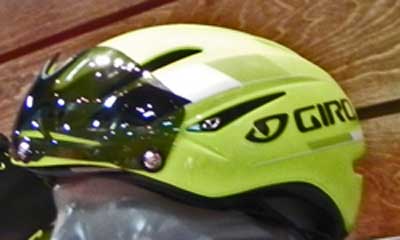Bicycle Helmet Types
Summary: Descriptions of typical road, mountain, commuter, skate, BMX, downhill racing, chrono, youth, toddler and women's helmets.
These are descriptions of the typical helmet in each category. We also have a page up with definitions of helmet terms.
Road

The original bike helmets were made for bicycling on roads and road racing. As they have evolved, they mostly had an
elongated shape, always with vents, and are usually made with EPS foam covered by a thin plastic shell. These are the
most-used helmets in the world, and millions of them are sold every year.
Commuter

The term coined by Bell in 2004 when they introduced their Metro model. It has come to mean a helmet with a rounded
shape, rather than the elongated road style. Has vents, and is usually made with EPS foam covered by a thin plastic
shell. It sometimes has accessories such as mirrors, winter ear flaps and rear blinkers that are useful for
commuting.
Trail

Trail riding models were in almost every line for 2016. The term has come to identify helmets with blocky lines and vents that have the appearance of lower coverage in the rear because the rear angles downward. Note, however that not every helmet in this style actually has additional rear coverage. Manufacturers know that many buyers are looking for that, so they are designed with the L shape from the side, but when you put on many of them and position them correctly on your head the "additional coverage" disappears as the front edge comes down to your brow line. We refer to all of them as "has the appearance of additional coverage" below, and you have to verify on your own head whether or not they actually work out that way when correctly positioned. Extended coverage has a fit advantage, since helmets with lower rear coverage are less likely to ride up in front to expose your forehead, and are generally easier to fit well. They may seem to be the answer if your helmet seems to perch way up on top of your head. We have no test results showing that anybody's lower coverage actually manages impact energy well, but having the helmet there is certainly better than hitting your bare head.
Enduro
Enduro helmets appeared in many lines for 2015 and continue to expand. They are designed for enduro racing--stage
races with riders racing the clock over timed downhill courses. Between downhill stages, the racers have to climb to get
to the next course, so there is a premium on ventilation and light weight, and riders are sometimes willing to compromise
on protection to get that. Some manufacturers just designate road models as their enduro models, but the form generally
resembles a downhill mountain bike racing helmet, often with a chinbar. The level of protection needed would seem to call
for downhill helmets, but enduro models may or may not meet the more demanding ASTM F1952 downhill mountain bike racing
standard.
Youth
Usually a small or medium road or mountain helmet, designed for riders from about 10 to 15. Graphics usually reflect
youthful themes. Has vents and is usually made with EPS foam covered by a thin plastic shell.
Child
For children between the ages of 5 and 10. Can be just a smaller youth model, resembling a road helmet, or can have a
rounder shape like a toddler helmet. Tested under the CPSC standard with exactly the same headform weight and drops as an
adult helmet. The age categories are blurred by head size variations, and if the helmet fits the head the age tag can be
disregarded.
Toddler

Made for very young children, usually under the age of five. Typically round and smooth. Extra rear coverage has
always been part of toddler helmets, and is required to pass the CPSC standard if the helmet is designed for children
under the age of 5. If the foam is thick in the rear, the child should be supported by a pillow behind the back if
transported in a trailer or high-backed child seat to avoid forcing the head forward and down. Tested under the CPSC
standard with exactly the same headform weight and drops as an adult helmet.
Women's Road
A helmet designed for a woman must have a place for long hair, usually a pony tail port. That should be a channel in the foam in the rear. There were a few such helmets in the early 1990's, but they disappeared after men stopped wearing their hair long. Today the term denotes the same helmet design sold to men, but in a medium size and with pastel graphics or perhaps a flower or two.
Giro's 2013 catalog was unusually frank about women's helmets: "What about fit for women? - While it is obvious that
anatomical differences between men and women can dictate different patterning and fit for many items worn on the body,
the head and skull are somewhat unique. When measuring men and women's heads, there is no significant difference in the
skull shape, location of skull features or the scale of the ears, eyes and nose between men and women." That of course
was written by a person without a pony tail.
Aero Road
The aero road is a road helmet made more aerodynamic, often by covering the vents. Some have adjustable vents, or use
vent plugs.


They are used by pros in some races, but abandoned for stages where ventilation becomes critical. They will not improve
the average road rider's performance very much since the average male reportedly rides at 15.6 mph (25 kph) and the
average female rides at 13.4 mph (21 kph) according to uploads to
Strava. They are not as slick as a chrono time trial helmet, but some riders might want one for the image, and some
aero road helmets have the rounder, smoother profile that we recommend.
Downhill mountain bike racing
A lightweight motorcycle-style helmet, usually with a chinbar to give some facial protection. Used in off-road
downhill races, usually on wooded terrain with rough courses. Generally has vents, and is made of EPS foam with either a
thin plastic shell or a thicker one made of either plastic or a composite material such as fiberglass or carbon fiber.
One of the few choices for road riders who want facial protection but must have vents. The best are certified to the ASTM
F1952 Downhill Racing Helmet standard.
Mountain
An artificial distinction, actually a type of road helmet. The term has come to mean "has a visor" for many manufacturers. In the past, one manufacturer advertised a former road helmet with extra large top vents to let warm air rise during very slow off-road riding, but that one has been discontinued.
BMX
A lightweight to full weight motorcycle-style helmet. Some are just motorcycle helmets sold to BMX (Bicycle Moto-Cross) riders. Always has a chinbar for facial protection, and usually has a big, squared off visor bolted to the helmet. Made of EPS foam with a shell of plastic or composite material such as fiberglass or carbon fiber. Sometimes has vents, but usually small ones, since BMX races are usually short. Some are certified to the ASTM F 2032 BMX bicycle helmet standard, others to the more protective DOT motorcycle standard. Only the Snell M-2005 motorcycle standard requires impact energy management in the chinbar in the form of crushable foam.
Chrono
A helmet made for aerodynamic efficiency at racing speeds in time trials and track pursuit events. One is simply a round ball, but most are elongated teardrop shapes. Some have very long tails that sit on the rider's back and blend the profile into a streamlined shape. When riders sit up or look down the tail is hoisted up into the airstream. At least one is designed to buzz if the tail is out of position. The most aerodynamic models have no vents to spoil the smooth flow of air around the shell. This coupled with the lack of aero effect at normal street speeds limits this type of helmet to track or time trail use. In a crash, the long tail would be like a lever to jerk the head. Race organizers now require these helmets to have impact protection, so they are made with EPS foam and a light plastic shell. We have a page up on chrono helmets.
Skate

Skate helmets began as round smooth hard shell helmets in the 1970's, and skateboarders cling to that shape still. It
is in fact the best shape for hitting pavement at high speed. The shell is usually hard ABS plastic, and the interior
foam can be EPS, EPP or a variation of those types. Skate helmets were once made with a squishy butyl nitrile foam that
works well in lesser impacts but cannot handle the energy of a full hit from a bicycle, or even some skateboard crashes.
Some are still made that way. Skate helmets traditionally have very small round vents that do not move enough air for
comfortable bicycle riding. There is an ASTM F 1492 Skateboard helmet standard, but most skate helmets now in the US
market are certified only to the CPSC bicycle helmet standard. The best are dual certified to
both standards.
Others
The Consumer Product Safety Commission has a very useful chart of helmets matched to various activities on their website.
Back to the top
Back to the Home Page